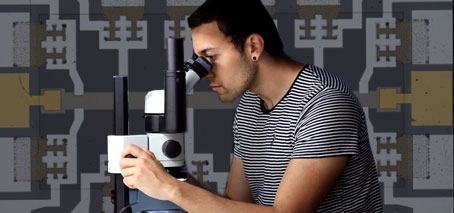Australian team takes new approach to building HEMTs

Growing an ultra-thin metal gate as part of the semiconductor crystal reduces unwanted effects from surface imperfections
A University of New South Wales (UNSW) study shows that ‘growing’ electronic components directly onto a semiconductor block avoids messy, noisy oxidation scattering that slows and impedes electronic operation.
The paper 'High electron mobility and low noise quantum point contacts in an ultra-shallow all-epitaxial metal gate GaAs / AlxGa1–xAs heterostructure' was publsihed in Applied Physics Letters.
“In the new work we create transistors in which an ultra-thin metal gate is grown as part of the semiconductor crystal, preventing problems associated with oxidation of the semiconductor surface,” says lead author Yonatan Ashlea Alava.
“We have demonstrated that this new design dramatically reduces unwanted effects from surface imperfections, and show that nanoscale quantum point contacts exhibit significantly lower noise than devices fabricated using conventional approaches,” says Yonatan, who is a FLEET PhD student.
“This new all single-crystal design will be ideal for making ultra-small electronic devices, quantum dots, and for qubit applications,” comments group leader Prof Alex Hamilton at UNSW.
HEMTs are optimised to have high conductivity (in comparison to conventional MOSFET devices) to provide lower device noise and enable higher frequency operations. Improving electron conduction within these devices should directly improve device performance in critical applications.
The quest to make increasingly smaller electronic devices demands the conducting channel in HEMTs to be in close proximity to the surface of the device. The challenging part, which has troubled many researchers over the years, has its roots in simple electron transport theory:
When electrons travel in solids, the electrostatic force due to unavoidable impurities/charge in the environment causes the electron trajectory to deviate from the original path: the so-called ‘electron scattering’ process. The more scattering events, the more difficult it is for electrons to travel in the solid, and thus the lower the conductivity.
The surface of semiconductors often has high levels of unwanted charge trapped by the unsatisfied chemical bonds– or ‘dangling’ bonds – of the surface atoms. This surface charge causes scattering of electrons in the channel and reduces the device conductivity. As a consequence, when the conducting channel is brought close to the surface, the performance/conductivity of the HEMT plunges rapidly.
Additionally, surface charge creates local potential fluctuations which, apart from lowering the conductivity, result in charge-noise in sensitive devices such as quantum point contacts and quantum dots.
Electrical characterisation of the new heterostructure device demonstrated greatly reduced surface-charge scattering, and a significant improvement in conductivity.
Collaborating with wafer growers at Cambridge University, the team at UNSW Sydney showed that the problem associated with surface charge can be eliminated by growing an epitaxial aluminium gate before removing the wafer from the growth chamber.
“We confirmed the performance improvement via characterisation measurements in the lab at UNSW,” says co-author Daisy Wang.
The team compared shallow HEMTs fabricated on two wafers with nearly-identical structures and growth conditions – one with an epitaxial aluminium gate, and a second with an ex-situ metal gate deposited on an aluminium oxide dielectric.
They characterised the devices using low-temperature transport measurements and showed the epitaxial gate design greatly reduced surface-charge scattering, with up to 2.5× increase in conductivity.
They also showed that the epitaxial aluminium gate can be patterned to make nanostructures. A quantum-point contact fabricated using the proposed structure showed robust and reproducible 1D conductance quantisation, with extremely low charge noise.
The high conductivity in ultra-shallow wafers, and the compatibility of the structure with reproducible nano-device fabrication, suggests that MBE-grown aluminium gated wafers are ideal candidates for making ultra-small electronic devices, quantum dots, and for qubit applications.
'High electron mobility and low noise quantum point contacts in an ultra-shallow all-epitaxial metal gate GaAs / AlxGa1–xAs heterostructure' by Yonatan Ashlea Alava et al; Applied Physics Letters, August 2021.


































